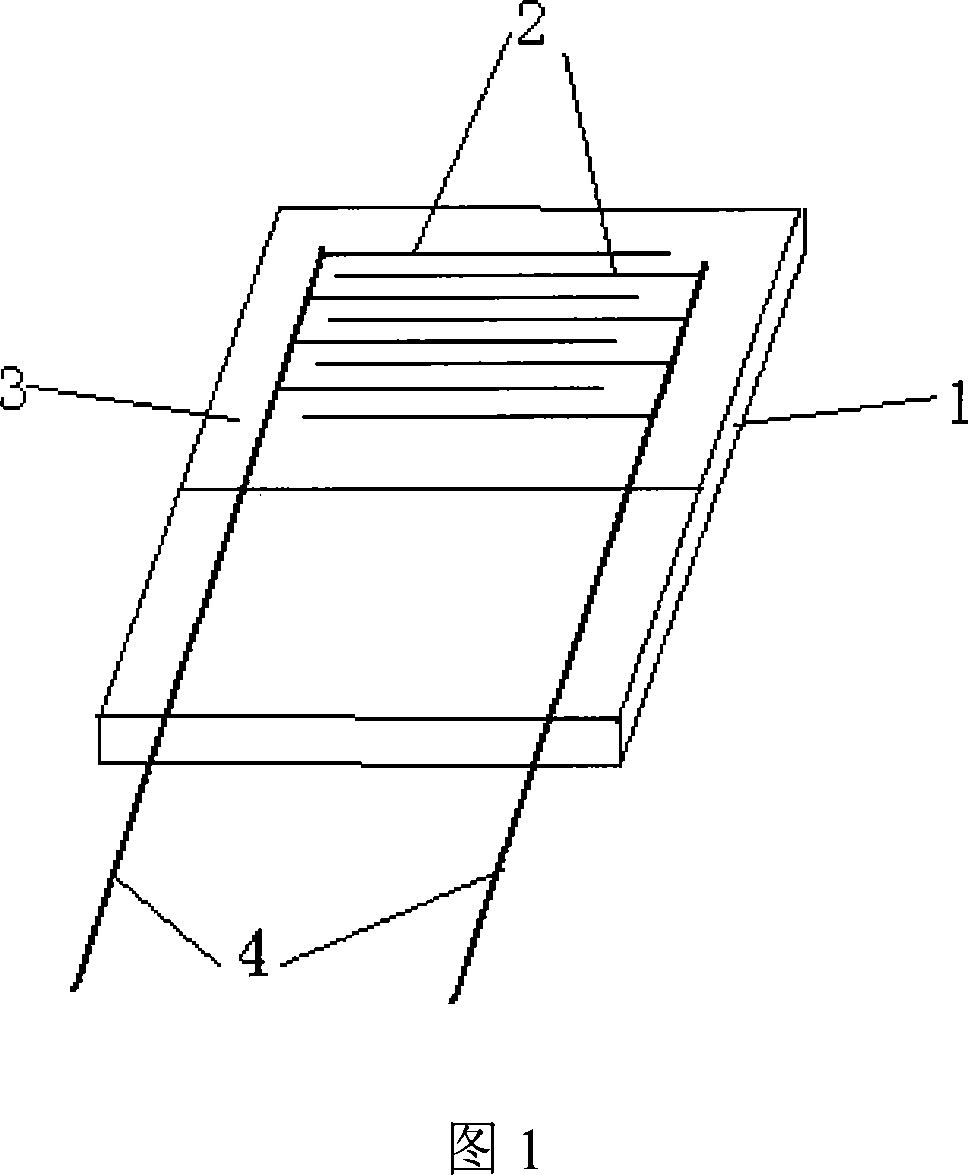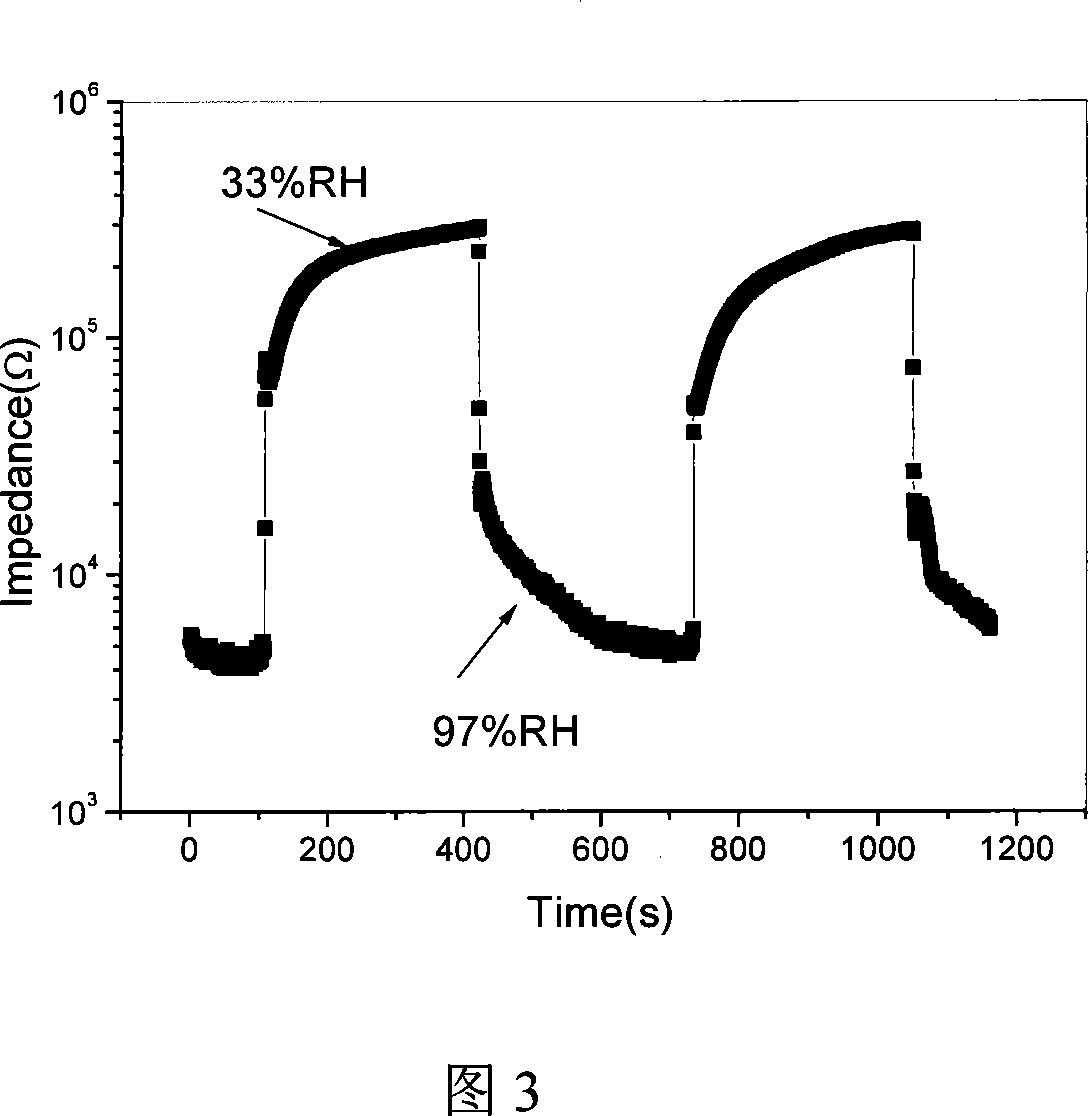Polyelectrolyte / intrinsic conducting polymer composite humidity sensor and its production method
A technology of composite humidity sensor and polyelectrolyte, which is applied in the field of polyelectrolyte/intrinsically conductive polymer composite humidity sensor, can solve the problems of low ion mobility, excessive resistance value, hindering development, etc., and achieve good response linearity , improve consistency, and improve stability
- Summary
- Abstract
- Description
- Claims
- Application Information
AI Technical Summary
Problems solved by technology
Method used
Image
Examples
Embodiment 1
[0030] 1) Soak and clean the glass-ceramics substrate with interdigitated gold electrodes on the surface photoetched and evaporated with absolute ethanol and acetone, and dry for later use;
[0031] 2) Dissolve poly 4-vinylpyridine and 1,4-dibromobutane in N,N-dimethylformamide, the 4-vinylpyridine unit in the polymer and 1,4-dibromobutane The molar ratio of the solution is 1:0.5, prepared into a solution with a polymer concentration of 10 mg / ml, and placed at 30° C. for 4 hours to obtain a precursor solution;
[0032] 3) Use a dipping machine to immerse the glass-ceramic interdigitated gold electrode in step 1) in the precursor solution for 0.5 minutes, pull it out, cross-link and quaternize it at 80°C for 12 hours, and place it on the glass-ceramic interdigitated gold electrode A polyelectrolyte basement membrane is formed on the surface;
[0033] 4) Ammonium persulfate and 4-methylbenzenesulfonic acid were dissolved in deionized water, the mass ratio of ammonium persulfate...
Embodiment 2
[0036] 1) Electrode cleaning is the same as in Example 1;
[0037] 2) Dissolve poly 4-vinylpyridine and 1,4-dibromobutane in N,N-dimethylformamide, the 4-vinylpyridine unit in the polymer and 1,4-dibromobutane The molar ratio is 1:2, and it is prepared into a solution with a polymer concentration of 30 mg / ml, and placed at 30° C. for 12 hours to obtain a precursor solution;
[0038] 3) Use a dipping machine to immerse the glass-ceramic interdigitated gold electrode in step 1) in the precursor solution for 2 minutes, pull it out, cross-link and quaternize it at 140°C for 2 hours, and coat the glass-ceramic interdigitated gold electrode A polyelectrolyte basement membrane is formed on the surface;
[0039] 4) Ammonium persulfate and 4-methylbenzenesulfonic acid were dissolved in deionized water, the mass ratio of ammonium persulfate and 4-methylbenzenesulfonic acid was 1:3, and the concentration of ammonium persulfate was 4 mg / ml, to obtain Solution A;
[0040] 5) Use a dippi...
Embodiment 3
[0042] 1) Electrode cleaning is the same as in Example 1;
[0043] 2) Dissolve poly 4-vinylpyridine and 1,4-dibromobutane in N,N-dimethylformamide, the 4-vinylpyridine unit in the polymer and 1,4-dibromobutane The molar ratio is 1:1, prepared into a solution with a polymer concentration of 24 mg / ml, and placed at 30° C. for 12 hours to obtain an electrolyte precursor solution;
[0044] 3) Use a dipping machine to immerse the glass-ceramic interdigitated gold electrode in step 1) in the precursor solution for 1 minute, pull it out, cross-link and quaternize it at 110°C for 10 hours, and coat the glass-ceramic interdigitated gold electrode A polyelectrolyte basement membrane is formed on the surface;
[0045] 4) Dissolving ammonium persulfate and 4-methylbenzenesulfonic acid in deionized water, the mass ratio of ammonium persulfate and 4-methylbenzenesulfonic acid is 1:2, the concentration of ammonium persulfate is 1.5 mg / ml, Obtain solution A;
[0046] 5) Use a dipping machine...
PUM
| Property | Measurement | Unit |
|---|---|---|
| width | aaaaa | aaaaa |
| interdigital gap | aaaaa | aaaaa |
Abstract
Description
Claims
Application Information
 Login to View More
Login to View More - R&D
- Intellectual Property
- Life Sciences
- Materials
- Tech Scout
- Unparalleled Data Quality
- Higher Quality Content
- 60% Fewer Hallucinations
Browse by: Latest US Patents, China's latest patents, Technical Efficacy Thesaurus, Application Domain, Technology Topic, Popular Technical Reports.
© 2025 PatSnap. All rights reserved.Legal|Privacy policy|Modern Slavery Act Transparency Statement|Sitemap|About US| Contact US: help@patsnap.com



